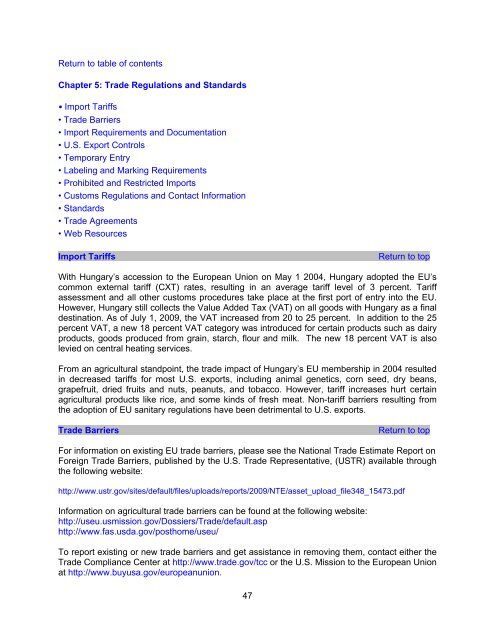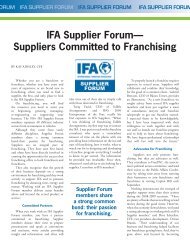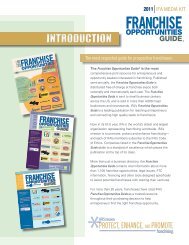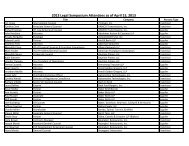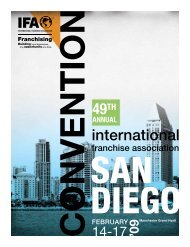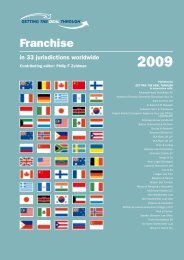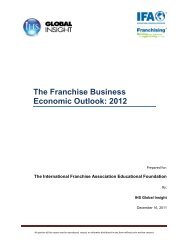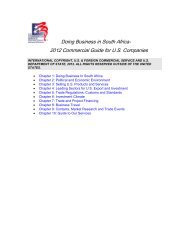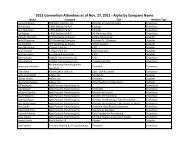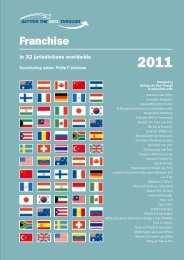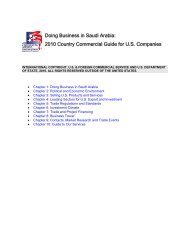Doing Business in Hungary 2010 - International Franchise Association
Doing Business in Hungary 2010 - International Franchise Association
Doing Business in Hungary 2010 - International Franchise Association
You also want an ePaper? Increase the reach of your titles
YUMPU automatically turns print PDFs into web optimized ePapers that Google loves.
Return to table of contents<br />
Chapter 5: Trade Regulations and Standards<br />
• Import Tariffs<br />
• Trade Barriers<br />
• Import Requirements and Documentation<br />
• U.S. Export Controls<br />
• Temporary Entry<br />
• Label<strong>in</strong>g and Mark<strong>in</strong>g Requirements<br />
• Prohibited and Restricted Imports<br />
• Customs Regulations and Contact Information<br />
• Standards<br />
• Trade Agreements<br />
• Web Resources<br />
Import Tariffs Return to top<br />
With <strong>Hungary</strong>’s accession to the European Union on May 1 2004, <strong>Hungary</strong> adopted the EU’s<br />
common external tariff (CXT) rates, result<strong>in</strong>g <strong>in</strong> an average tariff level of 3 percent. Tariff<br />
assessment and all other customs procedures take place at the first port of entry <strong>in</strong>to the EU.<br />
However, <strong>Hungary</strong> still collects the Value Added Tax (VAT) on all goods with <strong>Hungary</strong> as a f<strong>in</strong>al<br />
dest<strong>in</strong>ation. As of July 1, 2009, the VAT <strong>in</strong>creased from 20 to 25 percent. In addition to the 25<br />
percent VAT, a new 18 percent VAT category was <strong>in</strong>troduced for certa<strong>in</strong> products such as dairy<br />
products, goods produced from gra<strong>in</strong>, starch, flour and milk. The new 18 percent VAT is also<br />
levied on central heat<strong>in</strong>g services.<br />
From an agricultural standpo<strong>in</strong>t, the trade impact of <strong>Hungary</strong>’s EU membership <strong>in</strong> 2004 resulted<br />
<strong>in</strong> decreased tariffs for most U.S. exports, <strong>in</strong>clud<strong>in</strong>g animal genetics, corn seed, dry beans,<br />
grapefruit, dried fruits and nuts, peanuts, and tobacco. However, tariff <strong>in</strong>creases hurt certa<strong>in</strong><br />
agricultural products like rice, and some k<strong>in</strong>ds of fresh meat. Non-tariff barriers result<strong>in</strong>g from<br />
the adoption of EU sanitary regulations have been detrimental to U.S. exports.<br />
Trade Barriers Return to top<br />
For <strong>in</strong>formation on exist<strong>in</strong>g EU trade barriers, please see the National Trade Estimate Report on<br />
Foreign Trade Barriers, published by the U.S. Trade Representative, (USTR) available through<br />
the follow<strong>in</strong>g website:<br />
http://www.ustr.gov/sites/default/files/uploads/reports/2009/NTE/asset_upload_file348_15473.pdf<br />
Information on agricultural trade barriers can be found at the follow<strong>in</strong>g website:<br />
http://useu.usmission.gov/Dossiers/Trade/default.asp<br />
http://www.fas.usda.gov/posthome/useu/<br />
To report exist<strong>in</strong>g or new trade barriers and get assistance <strong>in</strong> remov<strong>in</strong>g them, contact either the<br />
Trade Compliance Center at http://www.trade.gov/tcc or the U.S. Mission to the European Union<br />
at http://www.buyusa.gov/europeanunion.<br />
47


